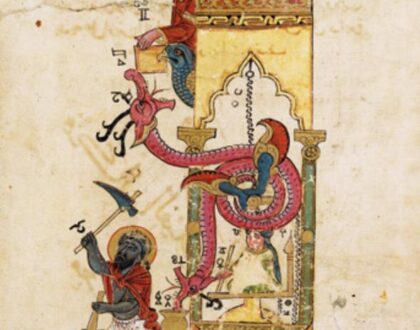The Inception of the Sunni-Shi’i (Shia) Divide

The Inception of the Sunni-Shi’i Divide
By Faysal Burhan
Published: 2018
Editor: Austin James
Abstract
Imam Ali Ibn Abi Talib’s succession to the Prophet Muhammad, peace be upon him (p), is widely seen as the cause of the Sunni-Shi’i (Shia or Shiite) divide. The real purpose of the divide, however, is not succession directly. Secondly, the most responsible element of the Sunni-Shi’i divide appears to be a desire to control.
Summary
The political dispute over the Muslims’ leadership after Prophet Muhammad (632 CE) arguably began the Sunni-Shi’i divide. Such a cause, however, was not the case. Instead, the split solidified after the massacre of seventy-five of the descendants of the Prophet Muhammad and their supporters at Karbala, Iraq, in 680 CE. The slaughter shook the Muslim world, creating a painful scar for the Sunnis and Shi’is.
Factually, the Karbala genocide crystallized Shi’ism, the group that supported promoting Imam Ali to the Muslims’ leadership. The Karbala slaughter’s accomplice was Yazid I (reign 680-683 CE), son of Muawiyah ibn Abi Sufyan (reign 661-680 CE) Umayyads. Yazid I was corrupt. The father (Abu Sufyan) and son (Muawiyah) were among Mecca’s Qurayshi elites and leaders. Abu Sufyan and Muawiyah opposed the Prophet Muhammad and the Muslims for twenty-one years. Nevertheless, after Mecca’s opening in 629 CE, they accepted Islam, and the Prophet gave amnesty to all the Meccans.
For 300 years after the Karbala massacre, the Sunni Shi’i divide deepened, and theology became grossly corrupt. However, despite jurisprudence differences, the fundamentals of Islamic belief are the same for Sunnis and Shi’is. See “The Muslims Outlook” below.
Discussion
Ali ibn Abi Talib was among a handful of people worthy of leading the Muslims upon Prophet Muhammad’s death in 632 CE. Moreover, Ali’s leadership qualification contains another criterion—a blood relationship to Prophet Muhammad as the first cousin and son-in-law. These qualities set Ali as most worthy of the first and follow-up posts of the Caliphate.
However, Ali did not become a caliph until the fourth term, reigning 654-661 CE. Nevertheless, he did not revolt against the previous Caliphs but gave allegiance to them and held serving posts during their periods. Until Imam Ali was appointed a Caliph for almost 26 years, there was no discernible sign or manifestation of the Sunni-Shi’i rift despite previous election disappointments. The sectoral Sunni Shi’i divide began when Muawiyah ibn Abi Sufyan, then the Governor of Damascus, appointed earlier by Caliph Umar, declined loyalty to the fourth elected Caliph, Ali ibn Abi Talib, and encouraged further revolts against the Caliphate. Muawiyah claims that Ali did not avenge the third Caliph’s assassination, Uthman, the former’s blood relative. Muawiyah’s rebellion led to his crowning as the first Umayyad Caliph (661-680 CE). “Corruption of the Ummah,” scholars said, was the high price of his crowning—divisions, loss of lives, plots, and assassinations are a few of such infections.
His claim to revenge was nothing less than a decoy to be in authority. To this date, many scholars and historians are skeptical about Muawiyah’s real intention of rebellion. Jamal al-Banna, a modern-day scholar and the younger brother to Hassan al-Banna, founder of the Muslim Brotherhood party, believes Muawiyah’s purpose was seizing power and leadership and regaining the position he had held in Mecca while opposing the Prophet Muhammad during the rise of Islam.
Even when he became a Caliph (661-680 CE), according to Dr. Adnan Ibrahim of Vienna, Austria, Muawiyah did not vindicate the assassins and ultimately appointed his son Yazid I, as the next Caliph. Such an appointment further deteriorated the collapsed Ummah, for he began a monarchy system away from the democratically (shura, consultative-electoral) precedence set by the previous four caliphs.
From the Umayyad era until recently, monarchy systems continued governing in the Middle East and profoundly influenced theology and sectarianism, leading to continuous discord and enmity. In their ways, traditional and modern historians and scholars assert that the acts of Muawiyah were the major elements of Muslim decline. Dr. Ahmad Kuftaro, the late Grand Mufti of Syria, Dr. Ahmad al-Kubaisi, Dr. Adnan Ibrahim, and Jamal al-Banna are only a few scholars. Jamal al-Banna noted, “The Muslim world anguish for the last 1400 years, due in total, to the oppressive monarchy embarked on by Muawiyah.” Dr. Kubaisi argued that the Muslim downfall starts with Mauawiyah. He said: “Muawiyah should not be reasoned good companion of the Prophet, because God said in the Qur’an, ‘He (God) is pleased with the Muhajireen, (early Meccan Muslims who later migrated to Medina) and al-Ansar (the Medinan Muslims who received and welcomed the Meccan emigrants), and those who have followed them in well-doing [be-Ihsan ].'” (Qur’an 9:100) Al-Kubaisi remarked: “Muawiyah is of neither of the two groups nor did he follow their patterns in ‘goodness and well-doing.‘”
Dr. Ahmad Kuftaro proclaimed, “Had the Umayyads followed the Companions of the Prophet (al-Sahabah) patterns, Islam and Muslims would have been far better off on the global scene.”
The Question of Revenge
Dr. Ibrahim said the question of ‘revenge for Uthman’ was up to Uthman’s family. But even they did not get revenge because the killers’ identity was never substantiated. As the rebels attacked Uthman’s volunteering guards, actual events reveal that some were wounded. While attending to the injured, the insurgents entered the house of Uthman from a neighboring side, killing him and fleeing the scene before anyone could identify them. Dr. Ibrahim stated, “there was no definitive killer(s),” therefore, no legal case was brought before the court—the realities of Muawiya’s unruliness point to other gains, power, and authority.
The Gluttony for Power and Control
Likewise, in addressing The Emergence of the Sunni Shi’i Divide, Dr. Khaled Abou El Fadl of UCLA raised a compelling question, “What to do about the detrimental effect of unjust and corrupt political power on a nation.” Could Muawiyah’s gluttony for control and authority be elemental in the conception of the Sunni-Shi’i divide? The following rundown of historical events from Prophet Muhammad’s death may provide more insight into the answer.
Chronological Run Down of the Sunni-Shi’i Emergence
I- Activities Pursued the Death of the Prophet Muhammad
Most historians agree that after Prophet Muhammad’s death and during his procession, the Ansar (Medinan Muslims) started a politically motivated meeting to select the Caliph (Successor) from amongst themselves.
Abu Ubaida Ibn Al-Jarah, an early Meccan companion of the Prophet, considered the meeting to split the Islamic Nation (Ummah). With Umar Ibn Al-Khattab and Abu Bakr, Al Ansar was convinced not to divide the Ummah into political entities. Abu Bakr, the first man to commit to Islam, was nominated and elected as the first Caliph (632-634 CE). It is believed Ali Ibn Abi Talib did not attend this meeting as he was busy with the Prophet’s death procession.
Dr. Abou El Fadl states, “Shi’ism did not manifest because Imam Ali’s claim to the Caliphate post was ignored.” In similar elections, there must be one candidate who will occupy the position. Several companions asked Imam Ali to seek the Caliphate position, but he did not take action. Abu Bakr’s appointment process to be the Caliph did not appeal to Ali. However, he did not rebel against him. He did not commit any opposition either in words or actions. On the contrary, he had wisely participated in Abu Bakr’s and the subsequent two caliphs’ governments. There are no historical narrations to indicate that Ali showed any opposition. Neither was any condemnation of a saying or action against Ali. For Dr. Abu El Fadl, “The notation that Imam Ali should have been the first caliph and hence is the divide is more schismatic theology than history.” See, https://www.youtube.com/watch?v=PtD7IspRy-g
For Caliphs’ sequence, Umar Ibn Al-Khattab became the second one (634-644 CE). During Umar’s reign, the Caliphate expanded to Egypt, Greater Syria, and Persia. Before his death, Umar appointed six people to an elector’s council (Shura Council) to nominate and elect the next Caliph. The Shura Council appointed Uthman Ibn Affan as the third Caliph.
II- Uthman’s Reign’s Political Deterioration
Uthman Ibn Affan’s reign 644-656 CE exhibited stability and success early but later deteriorated and ended with Uthman’s assassination. Among other things, the assassins accused Uthman of appointing members of his kin to essential governors’ posts in the open land. Uthman’s Umayyad relative and assistant, Marwan Ibn al-Hakam, had greatly influenced the eighty-three-year-old Caliph. Major demonstrations from Egypt and Iraq marched into Medina, demanding Uthman’s resignation. Uthman, however, did not quit. Demonstrators, turning into rioters, surrounded the Caliph’s house, stormed into it, and murdered the Caliph. Such a commotion destabilized the Caliphate and the unity of the Muslims. Imam Ali and his sons Hassan and Husain played significant roles in the negotiations between the rebels and Uthman and in protecting the Caliph. (https://en.wikipedia.org/wiki/Siege_of_Uthman)
Imam Ali reluctantly became the fourth Caliph (656-661 CE). Dr. Abou El Fadl elaborates: “At first, Imam Ali refused the Caliph nomination. He was horrified by the assassination of Uthman and did not wish to appear to be benefiting from the situation. Finally, however, his supporters Talha and al-Zubayr, the two former members of the Shura Council, advised him to be the Caliph for that only he had the authority to prevent the Caliphate from further disintegration.”
Imam Ali accepted the Caliph’s responsibility to rectify the situation for the Islamic nation’s best interests. But the magnitude of chaos and the greed to seize power by Muawiyah persisted and stirred up further disruption.
III- Muawiyah’s Rebellious and Ali’s Assassination
In 639 CE, during Umar Ibn Al-Khattab’s reign, Muawiyah Ibn Abi Sufyan was appointed the Governor of Damascus, Syria. Muawiyah was the son of Abu Sufyan, the prominent leader of Quraysh, and a relative of Uthman Ibn Affan. Both father and son were the men in power in Mecca, and they persecuted the Prophet and the Muslims for nearly twenty-one years. Later both father and son accepted Islam after the opening of Mecca in 629 CE. Then, the Prophet gave amnesty to all the Meccans. After the pardon, those who embraced Islam are described as at-Tulaqaa, the pardoned, such as Abu Sufyan and his son Muawiyah.
Muawiyah refused loyalty to Imam Ali as the new Caliph and accused him of not avenging Uthman’s assassination. A series of letters between Ali and Muawiyah aiming at reconciliation before the violent encounter of Siffin did not prove fruitful. The latter ordered clergies to curse Imam Ali in the Friday congregational prayers. Each side prepared an army for combat at the Battle of Siffin (657 CE). Even though he was on the victorious side, to stop the blood-shedding, Imam Ali agreed to negotiate with Muawiyah. Ali’s supporters (al-Khawareg) disagreed with Ali’s negotiation choice. They plotted to assassinate both Muawiyah and Ali. They did kill Ali (661 CE), but Muawiyah was only injured and later recovered from his wounds.
IV- Imam Hassan Becomes the Fifth Caliph
Hassan Ibn Ali became the next Caliph after his father was murdered. All Muslims nominated him except Muawiyah. Rather than conflicting with Muawiyah, Imam Hassan followed in his father’s footsteps and chose to save the Muslims’ blood and unity. His settlement conditions with Muawiyah were documented in an agreement that: 1) Hassan abdicates to Muawiyah, and the latter becomes the Caliph, 2) Imam Hassan will be the Caliph after Muawiyah’s death, and or the Ummah shall choose the next Caliph, and 3) The cursing of Imam Ali shall be stopped during Friday prayers that had been mandated on congregations by Muawiyah.
Many Muslims believe that Muawiyah plotted for Imam Hassan to be poisoned by his wife, Ja’da bint al-Ash’ath (670 CE). In 680 CE, Muawiyah violated Imam Hassan’s accord and appointed his son Yazid I to the Caliphate post. The Muslim Ummah was not content about Yazid’s I appointment. Aside from turning the governing system into a dictatorship, Yazid, I was known to be corrupt, a drunk, a womanizer, and an immoral man.
V- Massacre of the Household of the Prophet
Imam Hussain is the younger son of Imam Ali Ibn Abi Talib. He argued that the Ummah should choose its ruler, so he did not pledge to Yazid when only his father, Muawiyah, appointed him. Moreover, the people of Kufa in Iraq, where Ali Ibn Abi Talib ruled as a Caliph, wrote to Imam Hussain to be their Imam. So, with seventy-five family members and supporters, Hussain moved to Kufa.
Learning about Imam Hussain’s plans, Yazid removed the governor of Kufa and appointed a new one who sent an army to intercept Hussain. Unfortunately, Yazid’s new governor plotted to make supporters of Hussain break their promise to him. As a result, Yazid’s army blocked and massacred the Prophet’s descendants in Karbala, Iraq. This massacre is an excruciating episode in the history of Islam. Dr. Abu El Fadl describes this tormenting event as the ‘straw that broke the camel’s back’ that divided Muslims into the Sunnis and Shi’is.
Unjustified Demeanors
The divide deepened for the next 300 years, and theology became grossly corrupt. Political power exploited zealots who fabricated sayings attributed to the Prophet Muhamad (p) to serve their agendas. Others, including nine Shi’i Imams of the Prophet’s descendants, were mysteriously and systematically poisoned. The Umayyad authorities questioned no one for the criminal activities nor pursued any investigation for these murders. The unjustified killing of the Prophet’s descendants fueled hatred, created hostility, and intensified the Shi’i-Sunni divide.
The Umayyads did not just limit their aggression to the Prophet’s family’s household but also to anyone who voiced their concern about the injustice done. Among the Prophet’s companions and non-companions killed or poisoned were Abdul al-Rahman ibn Khalid ibn al-Waleed, Amar ibn Yaser, Abu Thar al-Ghfari, Hijr ben Addi, and Umar ibn Abd Al-Aziz—the latter is one of their rulers (717-720 CE), but realized his people’s aberrations, resent the cursing of Ali set by Muawiyah, and returned illegally confiscated properties to their owners. These individuals met their fate for being fair and speaking their minds. Reference: Series of video lectures titled “Muawiyah Under Scrutiny.”
The State of Theology
The question that one needs to tackle in this context is if there was an event during the lifetime of Prophet Muhammad (p) elemental in the Sunni-Shi’i divide. Dr. Abou El Fadl asserts, “Historically, not likely, theologically, yes, but only on the Shi’i side in what is referred to as the Ghadir al Khumm event.” This is where Shiites claimed that Prophet Muhammad appointed Ali as his successor. Yet, this turned out to be a controversial issue of linguistic vocabulary that the Prophet used to defend and support his cousin in his dispute with two people in Yemen. See Ghadir al Khumm Event below.
After the massacre of Karbala, corrupt politicians committed an adulteration of prophetic speeches that were falsely attributed to Prophet Muhammad (p). Furthermore, they manipulated the Prophet’s teachings and moral reflective lectures (Hadith) even to excuse themselves for committing crimes of killing others in the name of Islam. Hadith scholars were afraid of being killed if they disputed the Hadith Ali and his supporters were spreading.
Sahih al-Bukhari is the icon of Sunni authentic Hadith. It contains only twenty-five (25) hadiths of the Prophet Muhammad narrated by Imam Ali. Dr. Adnan Ibrahim of Vienna elaborates on this point by questioning if this small number of Hadith truthfully represents the rich experience and learning of Imam Ali from the Prophet Muhammad. Imam Ali accompanied the Prophet for twenty-three years during Revelation and lived twenty-nine years after his death. During his later years, he taught the Islamic Faith and Muhammad’s prophetic attributes (p). Ali was married to Fatimah, who was the Prophet’s daughter. The twenty-five hadiths proved to be spoken by Ali is a minimal number compared to the hundreds and thousands of hadiths narrated by other Prophet companions, some of whom had accompanied the Prophet for only two and one-half years. For example, Abu Hurairah is a companion whose narration is over five thousand hadiths and was briefly in the Prophet’s company. See, https://www.youtube.com/watch?v=rBsPiZm27pI&t=3311s
Additionally, the book “Mawta’ Malik,” based on the Maliki Islamic school of thought, does not contain a single hadith for Imam Ali. Dr. Ibrahim connects this omission of Ali’s sacred knowledge and life experience with the Prophet to Muawiya’s political manipulation and corruption. Such manipulation and control falsified information and evidence misinformation, throwing people into darkness and confusion.
In this context, the author believes foul political powers created Shiism (Shi’i Sect). It is an act of complicity that serves negative theology. Besides logical analysis, historical narrations and events do not provide evidence that the denial of leadership to Imam Ali is the pertinent cause for the Sunnis versus Shi’is sectarianism.
Ghadir al-Khumm Event
Shi’i and Sunni sources report that Prophet Muhammad (p) returned from Mecca to Madina after his Farewell Pilgrimage. He gathered over one hundred thousand people at Ghadir al Khumm. In his speech, he addressed all followers to unite and join on the prophetic path that Ali Ibn Abi Talib had walked with the Prophet. He delivered a speech to invite all Islamic Faith followers to learn from the firsthand experience of Ali. Within a full contextual speech lies the words that quote, “For whoever I am his mawla, ‘Ali is his mawla.“ https://www.al-islam.org
The Shiites elaborated on the Prophet’s word ‘mawla’ to assign the next leader to follow after the Prophet’s death. As there are problematic words in any language, ‘mawla’ in Arabic has various meanings, like a supporter, servant, leader, patron, partner, and ally. But the Prophet’s words meant Ali’s stature is as much as I am.
The Sunni scholar Shaykh Hassan Farhan al-Maliky argues that Ghadir al-Khum and what the Prophet stated about Ali were authentic. Perhaps, Ali’s leadership could be spiritual guidance, as is the Prophet’s, since Ali has been the closest to the Prophet’s household. He lived in Muhammad’s house for eight years before the Revelation and twenty-three years after. In many ways, Ali was the right hand to the Prophet throughout. Ali’s knowledge and experience are the closest to the Prophet’s; therefore, the Prophet would recommend him to be a leader resembling him.
In his book “The Succession to Muhammad,” Wilferd Madelung explains on page 18 that Ghadir al Khumm took place before the Farewell Pilgrimage. The Prophet counseled Ali and two people on official business in Yemen. There was a dispute between them and Ali on some issues. When the Prophet discovered this dispute, he advised his companions to agree with Ali, for he was on the right side. Madelung’s view and understanding conform to the Sunnis’ contextual conception of the event. Follow the link to the reports of the disputed story. https://www.al-islam.org/ghadir/incident.htm
The Muslims Outlook
Within Islam are two major sects. The Sunni and Shi’i. In each division are several schools of thought: Maliki, Shafi’i, Hanafi, and Hanbali are the primary schools for the Sunni division, and Ja’fari, Zaydi, and Ibadhi are schools in the Shi’i division. All schools of thought in both divisions are jurisprudential. Moreover, there are several Shi’i factions within the Shi’i division. The Imamates is the largest, followed by the Ismaili.
Per an Egyptian television interview with Dr. Ibrahim, the Sunni-Shi’i sects share the same Islamic fundamentals and beliefs. Both divisions draw faith elements and articles from Islam’s sources: the Qur’an and the Traditions of Prophet Muhammad, the Hadith. When the Hadith turns into action, it is called Sunnah.
Schools of Thought and Their Varieties
The schools of thought developed due to the influx of people entering Islam in the conquered land. No fiqh or jurisprudent standards were in place for people to draw from. Fiqh schools tackle many matters, including civics, marital, inheritance, legal, and penal.
Conclusion
They are not electing Imam Ali as Caliph was not the direct cause of the Sunni Shi’ divide. The Qur’an and Prophet Muhammad are explicit regarding matters concerning people or the r lives. The Sunni Shi’i divide results from dishonesty and co-ruption—the basic teachings of the Qur’an direct people away from divisions and co motions. The lack of good faith often leads to the wrong d rection. The Sunni Shi’i divide contradicts God’s guidance and can only be the outcome of self-serving. Imam Ali and his son sided with conciliation and even stepped down from their rightly elected Caliph position to follow God’s injunctions. On the other hand, Muawiyah’s acts defy Islam’s teachings—an unreasonable revolt against a ruler, creating turmoil and civil war and disrupting security and s ability. All such deranged conduct to get to the ruling seat.
Recommended Posts

The Father of Robotics
May 18, 2020



